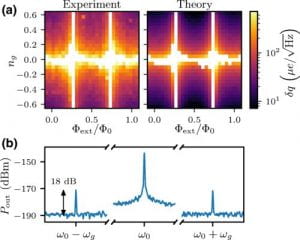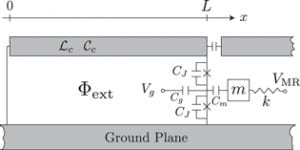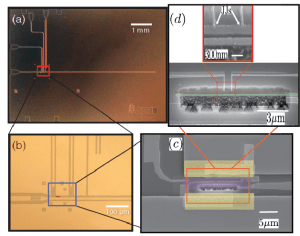Ultrasensitive Electrometry
Results

We demonstrate fast and ultrasensitive charge detection with a cavity-embedded Cooper pair transistor (cCPT) via dispersive readout of its Josephson inductance. We report a minimum charge sensitivityof 14 μe/√Hz with a detection bandwidth on the order of 1 MHz using 16 attowatts of power, corresponding to the single-photon level of the cavity. In addition, our measured sensitivities are within a factor of 5 of the quantum limit for this device. The single-photon-level sensitivity of the cCPT is comparable to that of the rf-SET, which typically operates using picowatts of power corresponding to hundreds of thousands of photons in its tank circuit. Our results support the feasibility of using the cCPT to mediate an optomechanical interaction that reaches the single-photon strong coupling regime.
Current Work
The cCPT is capable of operating as a quantum-limited electrometer as reported by Kanhirathingal et. al. Our current work focuses on improving the reported charge sensitivity closer to the photon shot-noise limited value. The two major approaches are -
1) Fabrication of samples with reduced quasiparticle poisoning that could allow access to the increased charge-sensitive regime.
2) Stabilization of resonance frequency fluctuations using feedback techniques that are induced by the intrinsic charge/flux noise in the sample. This allows better carrier signal to resonance frequency locking, ensuring improved charge sensing capabilities.
Low-frequency noise suppression
Current Work
The existence of two-level system-induced 1/f-noise is well-known to limit the efficiency and sensitivity of devices across a breadth of applications - ranging from semiconductor industry, to the emerging field of quantum computing processors. These systems can profoundly benefit from the real-time detection and suppression of 1/f-noise while performing measurements, which can significantly improve their performance. The gate-dependent tunability of the cCPT allows us to implement a feedback-scheme to diminish the intrinsic charge-noise of our device, which otherwise interferes with the cCPT's operation as a near quantum-limited electrometer. We believe our technique can be generalized to achieve frequency stabilization in tunable microwave resonators that play a vital role in today's quantum computing architecture, thereby moderating the limitations in detection caused by the intrinsic 1/f-noise on such samples.
(Manuscript under Preparation)
Quantum Optomechanics
Current Work

We are currently working on the realization of a scheme involving a Cooper pair transistor (CPT) embedded in a superconducting microwave cavity, where the CPT serves as a charge tunable quantum inductor to facilitate ultra-strong coupling between photons in the cavity and a nano- to meso-scale mechanical resonator.
The mechanical resonator is capacitively coupled to the CPT, such that mechanical displacements of the resonator cause a shift in the CPT inductance and hence the cavity's resonant frequency. The amplification provided by the CPT is sufficient for the zero point motion of the mechanical resonator alone to cause a significant change in the cavity resonance. Conversely, a single photon in the cavity causes a shift in th e mechanical resonator position on the order of its zero point motion. As a result, the cavity-Cooper pair transistor coupled to a mechanical resonator will be able to access a regime in which single photons can affect single phonons and vice versa. Realizing this ultra-strong coupling regime will facilitate the creation of non-classical states of the mechanical resonator, as well as the means to accurately characterize such states by measuring the cavity photon field.
e mechanical resonator position on the order of its zero point motion. As a result, the cavity-Cooper pair transistor coupled to a mechanical resonator will be able to access a regime in which single photons can affect single phonons and vice versa. Realizing this ultra-strong coupling regime will facilitate the creation of non-classical states of the mechanical resonator, as well as the means to accurately characterize such states by measuring the cavity photon field.